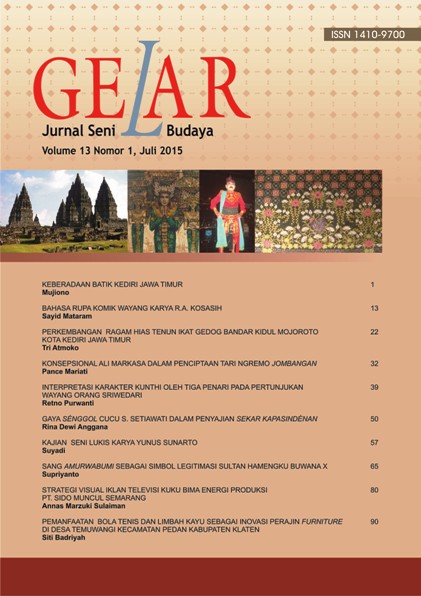BAHASA RUPA KOMIK WAYANG KARYA R.A. KOSASIH
Main Article Content
Abstract
Comic is a media of speech, like a language is, with the language system and individual application. Comicof puppet by R.A. Kosasih is one of the genres in constellation of Indonesia comic which is able to overcomethe influence of western comic. The problems analyzed in this research include how the form of visuallanguage and idiolect characteristics of puppet comic by R.A. Kosasih. This research aims to analyze thevisual language of puppet comic by R.A. Kosasih as well as the idiolect characteristic that is appeared to beits characteristic. The research uses an approach of language analogy using textual and contextual analysisof comic. The result shows that firstly, the visual language of comic is analog with language consisting oflanguage system and idiolect. The system of visual language in comic R.A. Kosasih consists of the basicelements of comic constituent covering panel and juxtaposition structure. Secondly, puppet comic by R.A.Kosasih uses stories based on Mahabarata epos and Ramayana in Indian version as well as Nusantarapuppet in which Sunda language is inserted. The picture and symbol in the comic is influenced by the realiststyle of Western comic and Indie Mooi stream and also the technology of the age. The relationship of puppetcomic juxtaposition is influenced by the story order and the session of lakon.
Keywords: comic, language, visual, puppet, idiolect
Downloads
Article Details
Copyright
Authors who publish with Gelar: Jurnal Seni Budaya agrees to the following terms:
- Authors retain copyright and grant the journal right of first publication with the work simultaneously licensed under a Creative Commons Attribution License (CC BY-SA 4.0) that allows others to share the work with an acknowledgment of the work's authorship and initial publication in this journal.
- Authors are able to enter into separate, additional contractual arrangements for the non-exclusive distribution of the journal's published version of the work (e.g., post it to an institutional repository or publish it in a book), with an acknowledgment of its initial publication in this journal.
- Authors are permitted and encouraged to post their work online (e.g., in institutional repositories or on their website) prior to and during the submission process, as it can lead to productive exchanges, as well as earlier and greater citation of published work.
